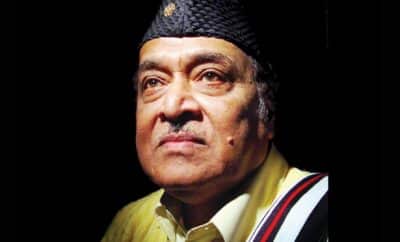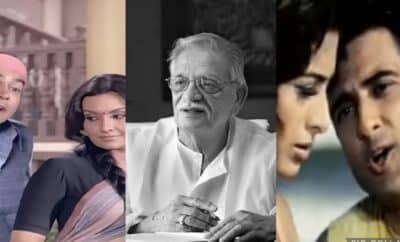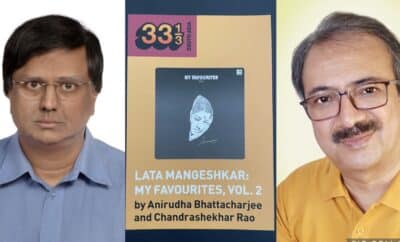Legends
C. Ramchandra – Master-chef of Desi Melodies with Videshi Tadkaa
Hindi cinema, more particularly Hindi film music (HFM), has always been the best example of unity in diversity in India. Due to the artistes hailing from every nook and cranny of the country, HFM has evolved as a different school of music in itself, with traces of music from not only various states of India, but also various other countries, mainly the western and the middle-eastern countries.
It is by and large believed that the western music started showing up in HFM with the entry of the celebrated composer duo Shankar-Jaikishan towards the end of the 1940s. No doubt, they made the use of western music popular by beautifully blending it with Indian music in their unique and grand style. But western music had already crept into HFM much before in that decade – take a glance at some compositions by C. Ramchandra (CR), for example.
CR, one of the stalwarts instrumental in shaping up the golden era music, composed in his unique style many toe-tapping numbers based on western music as well as many euphonious romantic and soulful numbers based on Indian classical music with equal proficiency. Besides the western influences on his compositions, he also introduced many western musical instruments in HFM – saxophone, bongo, conga, trumpet and clarinets, to name a few. The traces of western music in his compositions kept on becoming sporadic as his prolific association with Lata Mangeshkar marked by romantic and soulful numbers strengthened. However, he experimented a lot with the western music in the 1940s and the early 1950s, when his compeers were focusing mainly on Indian classical music.
For instance, through his celebrated composition “Aana meri jaan, meri jaan, Sunday ke Sunday” from Shehnai (1947), he introduced swing music in the Benny Goodman style of jazz clarinets for the first time in HFM. The producer Shashadhar Mukherjee wanted this “silly” song to be dropped from the film, but CR remained adamant about retaining it. The new style coupled with wacky lyrics weaved the magic and the song went on to become a major hit, though it fetched CR criticism from his once mentor, Anil Biswas and shocked the purists. The song was sung by CR himself, together with Shamshad Begum and Meena Kapoor. The swing portions sung by CR were picturised on Mehmood’s father, Mumtaz Ali.
A couple of years down the line, he gave another sensational hit – the first ever telephone song in Hindi films, “Mere piya gaye Rangoon” from Patanga (1949). How beautifully he has blended the western musical phrases and instruments with the Indian melody! Gop and Nigar Sultana express the pang of a distant relationship through the voices of CR himself and Shamshad Begum respectively and Rajendra Krishan’s quirky lyrics in an amusing manner. Though the song became and continues to be popular to date, it was once criticised by some for the so called “lowbrow” lyrics.
In the next year, he came up with another path-breaking number – “Gore gore o baanke chore” (Samadhi – 1950), a stage song sung by Lata Mangeshkar and Amribai Karnataki. This playfully romantic number also made the then youngsters tap their feet and nod their heads, but simultaneously invited criticism from orthodox music pundits. It continues to retain its popular appeal even today.
While he used western music in many a song, such songs were generally not copied or inspired from any western tune. This song, which was a replica of the tune of “Chico Chico from Puerto Rico” (Doll Face – 1945), was an however exception.
Interestingly, this tune was also replicated later in the Tamil song “Ayya sami” from “Or Iravu (1951)”.
“Gore gore, o baanke chore”, in contradistinction with a soft romantic song from the same film – “Abhi shaam aayegi, niklenge taare”, highlights the wide range of CR’s musical acumen.
Then came CR’s milestone work – Albela (1951). The soundtrack of the film comprised several songs based on Indian as well as western music – e.g., a melodious thumri-esque number “Balma bada nadan re”, a soulful lullaby “Dheere se aa ja ri” and peppy and zestful numbers like “Shola jo bhadke” and “Ye deewana, ye parwana”, both sung by CR and Lata Mangeshkar.
In these peppy numbers, he came up with an amazing fusion. Cabaret type choruses and western instruments like bongo, oboes, clarinets, trumpets, saxophone etc. were employed with the Indian melody. What’s more, Hawaiian and African sounds were also used in these songs. And the effect is evident – the charisma of these evergreen songs, particularly “Shola jo bhadke”, remains undiluted till date.
Another frisky and playful Lata – CR duet from the film – “Shaam dhale khidki tale” also deserves a mention in the league of his compositions with western influence.
In the following year, he introduced “doo-wop” vocal music style and rock rhythms through the title song of the film Shin Shinaki Boobla Boo (1952), which was again a Lata – CR duet.
Another glaring example of his compositions with western influence is “Eena mina dika” from Aasha (1957). The scat song based on “Rock and Roll” genre has two versions – one sung and performed by Kishore Kumar and the other sung by Asha Bhosle and performed by Vijayanti Mala. Though both the versions are frothy and catchy, Kishore Kumar’s version stands out due to his brimming energy on screen as well as on the mic. None other than him could have been a better choice for this song!
There is a tale about the creation of this song – when CR was discussing the music of the film with his Govan assistant John Gomes, a few kids were playing “eeni mieeni miini moh” nearby. Hearing them, CR penned the words – “Eena meena deeka, daai damanika”. John added the Konkani words “Maaka naaka naaka”. They kept on adding such unrelated weird words and thus the refrain of the song was created.
Another couple of soft, romantic songs composed by CR where subtle traces of western music can be seen are the Lata Mangeshkar – Talat Mehmood duet marked by lovely choir singing and harmony, “Dil dil se keh raha hai” from Parchhain (1952) and the beautiful Lata solo “Aankhon mein samaa jao” from Yasmeen (1957).
The videshi tadka that this gentle giant named CR added to his desi musical recipes gave the recipes an everlasting aroma, which makes his music an exception to the “law of diminishing marginal utility” –the more you listen to his music, the greater is the urge to listen to it again.




Madhupati Sharma
January 17, 2021 at 1:05 pm
Two of my favourites Ye Zindagi usi ki hai and Aye mere watan ke logon are desi. Shankar Jaikishan’s Videshi masala is so well mixed in ragas that it is a pire hindi film recipe. CR kept the character of Videshi Thaap as it is. Naushad used western orchestra in ragaas… Ye kaun aaya.
CR was a great innovator in big league of Musical eizards. Such a good article.
Enjoyed the recipe.